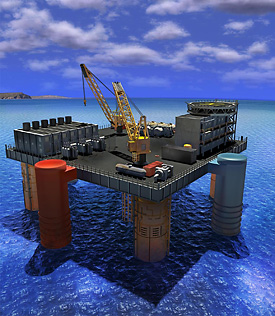Step two was build seasteads powered by Ocean Thermal Energy Conversion (OTEC) power.
The U.S. Naval Facilities Engineering Command awarded Lockheed Martin a $4.4 million contract modification to advance the design for an Ocean Thermal Energy Conversion (OTEC) pilot plant off the coast of Hawaii. The Hawaii pilot plant is expected to have a 10 megawatt capacity, and be operational by 2012 or 2013. It is hoped that its success will lead to commercial-sized plants generating 100 MW or better, by 2015.
Earlier OTEC systems had an overall efficiency of only 1 to 3% (the theoretical maximum efficiency lies between 6 and 7%). Current designs under review will operate closer to the theoretical maximum efficiency. The energy carrier, seawater, is free, though it has an access cost associated with the pumping materials and pump energy costs. Although an OTEC plant operates at a low overall efficiency, it can be configured to operate continuously as a Base load power generation system. Any thorough cost-benefit analysis should include these factors to provide an accurate assessment of performance, efficiency, operational, construction costs, and returns on investment.
India piloted a 1-MW floating OTEC plant near Tamil Nadu.
If you liked this article, please give it a quick review on ycombinator or StumbleUpon. Thanks
Featured articles
Ocean Floor Gold and Copper
Ocean Floor Mining Company

Brian Wang is a Futurist Thought Leader and a popular Science blogger with 1 million readers per month. His blog Nextbigfuture.com is ranked #1 Science News Blog. It covers many disruptive technology and trends including Space, Robotics, Artificial Intelligence, Medicine, Anti-aging Biotechnology, and Nanotechnology.
Known for identifying cutting edge technologies, he is currently a Co-Founder of a startup and fundraiser for high potential early-stage companies. He is the Head of Research for Allocations for deep technology investments and an Angel Investor at Space Angels.
A frequent speaker at corporations, he has been a TEDx speaker, a Singularity University speaker and guest at numerous interviews for radio and podcasts. He is open to public speaking and advising engagements.



